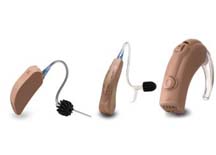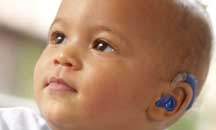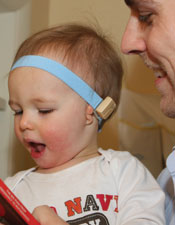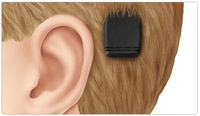Hearing Aids
Hearing aids enable many children with impaired hearing to hear better and, for many, well enough to develop normal speech, language, social communication, and learning skills. Determining whether hearing aids will be helpful for a child depends upon the type, severity and configuration of the hearing loss, family involvement, and follow-up interventions, including speech and language therapy. For children with hearing impairment, the primary aim of hearing aid use is to enable them to hear and understand sufficiently to develop their own speech and language. Hearing aids vary in their ideal application, technology, size, cost, durability, and potential complications. If chosen and used appropriately, hearing aids can be effective in allowing normal development in the face of hearing impairment.
Assessment and Evaluation
Evaluation of pediatric patients should be performed by a pediatric audiologist, trained and experienced in assessing children. After hearing loss is confirmed, the pediatric audiologist will refer the child to an otolaryngologist for further medical assessment. Together the otolaryngologist and the audiologist will collaborate with the family to determine the rehabilitation needs of the child. After hearing aids or cochlear implantation, children often need the services of speech therapy and early intervention in order to fully maximize speech, language and listening skills. Children fit with hearing aids should be monitored closely by a pediatric audiologist and by early intervention specialists and other professionals to ensure the hearing aids are set appropriately and are providing the maximum benefit. In the first weeks and months following the fitting of amplification on children, the audiologist will see the child often and use several subject and objective measures to insure the hearing aids are set appropriately and that the family is comfortable trouble-shooting any problems.
Types of Hearing Loss
Hearing loss can be categorized by the part of the auditory system that is impaired and the severity of the impairment. There are three basic types of hearing loss: conductive hearing loss, sensorineural hearing loss, and mixed hearing loss.
Conductive Hearing Loss
Sensorineural Hearing Loss
- Illnesses, including CMV, bacterial meningitis
- Drugs that are toxic to hearing
- Hearing loss that runs in the family (genetic or hereditary)
- Head trauma
- Malformation of the inner ear
- Exposure to loud noise
- Eighth nerve lesions
- Prematurity
Mixed Hearing Loss
Auditory Neuropathy Spectrum Disorder
Degree and Severity of Hearing Loss
Other Descriptors of Hearing Loss
- Bilateral versus unilateral.
- Symmetrical versus asymmetrical, depending on whether the degree and configuration of hearing loss are the same in each ear.
- Progressive versus sudden hearing loss – progressive means that hearing loss becomes worse over time. Sudden means hearing loss that happens quickly, which should prompt immediate medical attention to determine its cause and treatment.
- Fluctuating versus stable hearing loss.
Styles of Hearing Aids
The type, degree and configuration of hearing loss will determine which style of hearing aid may work best for the child, with smaller models generally suited for less significant losses and larger styles suited for any degree of hearing loss, including severe and profound.
Behind-the-ear (BTE) Aids

- It accommodates various earmold types.
- The earmold detaches and can be easily remade as the child grows.
- The earmold is easy to handle and clean.
- Parents and caregivers can easily do a listening check and make adjustments.
- It accommodates a wide variety of hearing losses.
- It can be made with direct audio input or a telecoil, so it can be used with other listening devices.
- The earmolds are made of a soft material that is safer and more comfortable for tiny ears.
Behind-the-ear Aid, Open Fitting
A small plastic case rests behind the ear, and a very fine clear tube runs into the ear canal. Inside the ear canal, a small, soft silicone dome or a molded, highly vented acrylic tip holds the tube in place. These aids offer cosmetic and listening advantages and are typically used for adults and some older children as well.
In-the-ear (ITE) Aids, In-the-canal (ITC), and Completely-in-the-canal (CIC) Aids

Other Types of Hearing Aids
CROS Hearing Aids
CROS hearing aids route sounds coming to one ear over to the other ear. These devices are for use by individuals who have no hearing in one ear. In special cases, hearing aids can be built into eye glasses for individuals who need that type of fitting.
Eyeglass Aids
Hearing aids and glasses were combined in the 1950s but are no longer seen as viable options in most cases.
Disposable Hearing Aids
Bone Conduction Hearing Aids
Bone conduction hearing aids use a headband and a bone vibrator for individuals who have no ear canal or outer ear. These devices bypass the outer and middle ear and directly stimulate the cochlea or inner ear. This is often the only alternative for children born with a permanent conductive hearing loss, such as atresia of the ear canal, or chronic draining otitis media that precludes fitting a hearing aid.
Osseointegrated Hearing Aid
Middle Ear Implants
Middle ear implants are hearing systems implanted in the space behind the eardrum that mechanically vibrate the middle ear structures. This device has two parts: an external portion and an implanted portion. Middle ear implants are used when a conductive hearing loss results from permanent damage to or the absence of the ossicles.
Cochlear Implants
A cochlear implant provides direct electrical stimulation to the auditory (hearing) nerve in the inner ear. Children and adults with a severe to profound sensorineural hearing loss who cannot be helped with hearing aids may be helped with cochlear implants. The cochlear implant does not result in “restored” or “cured” hearing. It does, however, allow for the perception of the sensation of sound. Children as young as 6 - 9 months of age have received cochlear implants, and the potential exists for successful implantation at younger ages.
It is generally agreed that the best child candidates for cochlear implant are those who:
- Have profound hearing loss in both ears
- Have had limited benefit from hearing aids
- Are healthy and have no medical conditions that would make the surgery risky
- Are involved (when able), along with their parents, in all the steps in the process
- Understand (when able), along with their parents, their role in the successful use of cochlear implants
- Have (when able), along with their parents, realistic expectations for cochlear implant use
- Are willing to be actively involved in their habilitation/rehabilitation
- Have support from their educational program to emphasize the development of auditory skills
Use & Care
Families and children should be familiar with the following components of a hearing aid.
Batteries
- Zinc air cell batteries are used in virtually all current-day hearing instruments. They are activated by removal of a tab which allows air to enter the battery and they have excellent shelf life when stored properly (approx. 2-3 years). These replaced mercury and silver oxide batteries. They are available in all sizes (675 to 5A) and high-power. Cost is ~ $1.00 per battery
- All hearing aid batteries are toxic. Keep them stored in a safe place away from children and pets. A swallowed battery is a medical emergency and the individual needs medical attention immediately. Call your local emergency number or the national Poison Control Center at 1-800-222-1222.
Microphone(s)
- Omnidirectional (omni) - have one port of entry for inputs and equal sensitivity to inputs from all directions; currently, most manufacturers offer an omni-directional microphone option in all styles including canal styles.
- Bidirectional - Not used very often
Other Components
- Receiver - converts electrical energy into acoustic energy
- Amplifier - amplifies the acoustic signal before it enters the ear canal
Types of Hearing Aid Circuitry
Digitally Programmable
- Analog components programmed/adjusted by an external digital source (computer)
Digital
- Both the audio circuit and the additional control circuits are fully digital.
- Hearing aid programmed with an external computer temporarily connected to the device. Fully digital hearing aids can be programmed with multiple programs that can be invoked by the wearer, or that operate automatically and adaptively. These programs reduce acoustic feedback (whistling), reduce background noise, detect and automatically accommodate different listening environments (loud vs soft, speech vs music, quiet vs noisy, etc.), control additional components such as multiple microphones to improve spatial hearing, transpose frequencies (shift high frequencies that a wearer may not hear to lower frequency regions where hearing may be better), and implement many other features. These programs can be determined on an individual basis for each patient.
Cleaning Your Hearing Aid
After removing the hearing aid from your ear, remove any wax from the ear mold or tubing with the hearing aid pick and wipe the exterior of the aid and mold with a soft cloth. These should be done daily.
Clean the battery compartment by removing the battery and gently brushing interior. Replace battery and close the casement.
Earmolds can be removed from the aid by first locating the end of the tube where it connects with the ear hook; then twist and pull gently. Using warm water and mild soap, wash the earmold, then rinse with clean water. Place the blower on the end of the tube and squeeze. This should force water out of the tube. Allow to dry overnight before reconnecting to ear hook.
Moisture
If moisture droplets are seen in hearing aid tubing, disconnect the tubing gently from ear hook and, with a hearing aid blower, blow air through the tubing to force out moisture and then allow it to dry overnight. With in-the-ear models, the only way to combat moisture is to remove them and allow them to dry out.
Never put your aids in a conventional or microwave oven to dry or leave them in direct sunlight. Excessive heat may melt plastic components and microwaves will destroy all of the electronic components.
Special moisture-dispersing tubing or “Dry Aid” kits are available and may be worth trying if moisture problems recur.
Hearing Aid Checks
First, check the exterior of aid for any cracks, holes or tears. Remove the battery and test with a hearing aid tester. After reinserting or replacing battery, close the compartment completely. Turn the O-T-M switch to “off” (O) position. Turn the volume to the lowest setting and turn the switch to the “microphone” (M) position. Put one end of a hearing aid stethoscope into the ears of a hearing person and say several vowel and consonant sounds. None should be distorted. Once the hearing aid has been checked and verified to be working properly, place it in the ear and listen for feedback. If feedback is present, remove the aid. Cover the opening of the canal in earmold with thumb. If you still hear feedback, there is a problem with the aid. If not, it means the earmold was not fitted tightly, which could be a sign of a bad fit.
Ear wax is the normal way that the ear protects the ear canal and ear drum (tympanic membrane). Most peoples’ ear canals clear wax without help. A hearing aid can impede this process resulting in wax build-up behind the earmold, which can damage a hearing aid. It can also cause hearing aid feedback—an extremely high-pitched whistling sound—and reduce hearing effectiveness by blocking sound.
No one should try to remove ear wax themselves. Using a swab or any object in the ear canal can push the wax back further and cause it to become impacted, which can cause pain and further hearing loss. Current guidelines from the American Academy of Otolaryngology—Head and Neck Surgery Foundation recommend that individuals with hearing aids have their ears cleaned professionally twice a year.
Costs & Funding
The cost of a single hearing aid can vary from $500 to $6,000 or more, depending on the level of technology and whether fitting
fees are included. Most private US health care providers do not provide coverage for hearing aids for adults, but some, including
many state Medicaid programs, cover hearing aids for children. Health Savings Accounts or HSAs should cover the costs. Some
school districts may conditionally cover the cost and use of hearing aids. Less expensive hearing aids can be found on the
internet or in mail order catalogs but some of these use poorly made sound amplifiers and are not recommended. The cost of
hearing aids is a tax-deductible medical expense for those who itemize medical deductions.
Diagnostic audiology evaluations may be performed with a physician’s written order and include procedures used to determine
hearing aid assessment and other appropriate diagnostic tests. Hearing aids and cochlear implants require prior authorization
and must meet eligibility requirements of Medicaid. Children should be evaluated for hearing aids by a pediatric audiologist
who can monitor the child’s response to the hearing aids and insure that they fit appropriately. In many states, before a
hearing aid can be fit on a child, an otolaryngologist must provide medical clearance in the form of a prescription. This
is to ensure that treatable causes of hearing loss have been assessed.
The life of a hearing aid depends on many factors, including care. In many cases a hearing aid can last up to five years
or longer. Some insurances will not authorize hearing aids more than once every five years unless the hearing loss has changed
significantly and the current aids are no longer appropriate. Many pediatric providers recommend hearing aids from companies
that are pediatric-friendly and offer extended warranties for loss and damage. There are also private insurance companies
that offer insurance plans that cover loss and damage of hearing aids and other assistive devices for a fee.
Resources
Information & Support
For Professionals
American Academy of Audiology
Resources for professionals who test, treat, and provide care to the deaf or hard of hearing.
American Speech-Language-Hearing Association
Information for professionals working in audiology, speech-language pathology, and the speech and hearing sciences. Advocate
for people with communication disabilities.
For Parents and Patients
Family Voices
A national, nonprofit, family-led organization promoting quality health care for all children and youth, particularly those
with special health care needs. Locate your Family-to-Family Health Information Center by state.
Hearing Aid Choices and Tips (My Baby's Hearing)
From a program of the Boystown National Research Hospital, answers to common questions about choosing and using hearing aids
for children and tips for how help children with them; note that the content is covered over 6 pages addressing specific aspects.
The HIKE Fund, Inc.
Hearing Impaired Kids Endowment Fund, supported by Job’s Daughters International, provides hearing devices for about 100 children
a year who have hearing loss and whose parents are unable to meet this special need financially.
Hear Now Program
The Hear Now Program of the Starkey Hearing Foundation is a national program providing assistance, to those permanently living
in the US, to acquire hearing aids through an application process. All applicants must meet the program's financial criteria.
Hear Now works with licensed practitioners in the applicant's area.
AUDIENT Alliance for Accessible Hearing Care
For individuals whose income is above the government's established poverty levels, but who still find it difficult to afford
quality hearing care.
Oticon Pediatric Hearing Aids
Oticon is a reputable manufacturer of pediatric hearing devices.
Miracle-Ear Childen's Foundation
Miracle-Ear Children's Foundation provides free hearing aids and services to children from low-income families.
Phonak Pediatric Hearing Aids
Phonak is a reputable manufacturer of pediatric hearing devices.
Cochlear Americas Baha Hearing Aids
Cochlear Americas is a leading manufacturer of bone-anchored hearing aids (BAHA).
Alexander Graham Bell Association
One of the oldest and most comprehensive organizations focused on pediatric hearing loss, including information on how to
find a provider, funding sources and information, scholarships, and a family support section.
Services for Patients & Families in Rhode Island (RI)
| Service Categories | # of providers* in: | RI | NW | Other states (3) (show) | | NM | NV | UT |
|---|---|---|---|---|---|---|---|---|
| Assistive Technology Equipment | 44 | 36 | 47 | 46 | 72 | |||
| Audiology | 24 | 3 | 22 | 8 | 22 | |||
| CSHCN Administration & Programs | 1 | 1 | 5 | 2 | 7 | |||
| Early Intervention for Children with Disabilities/Delays | 13 | 3 | 34 | 30 | 51 | |||
| Speech and Hearing Services | 20 | 7 | 36 | 12 | 29 | |||
For services not listed above, browse our Services categories or search our database.
* number of provider listings may vary by how states categorize services, whether providers are listed by organization or individual, how services are organized in the state, and other factors; Nationwide (NW) providers are generally limited to web-based services, provider locator services, and organizations that serve children from across the nation.
Studies
Clinical Trials Related to Hearing Aids in children (clinicaltrials.gov)
Studies looking at better understanding, diagnosing, and treating this condition; from the National Library of Medicine.
Authors & Reviewers
| Authors: | Nancy Hohler, AuD, MBA |
| Jeanne Raney, MA, SLP | |
| Reviewers: | Natalie Allen, RN |
| Jennifer Goldman, MD, MRP, FAAP |


 Get Help in Rhode Island
Get Help in Rhode Island
